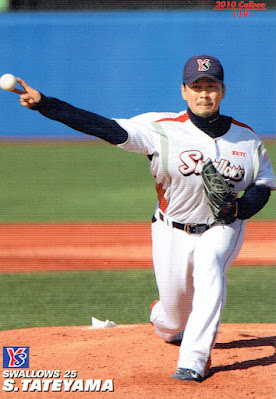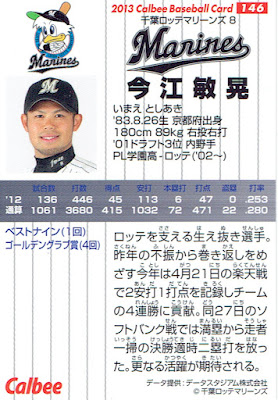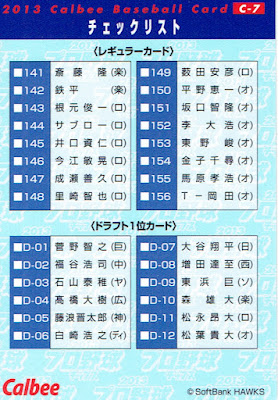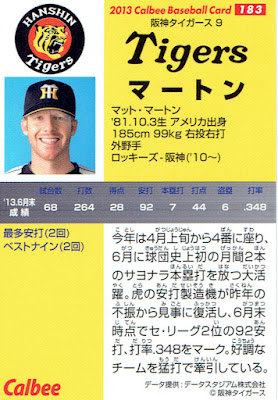2010
Despite the fronts being pretty much the same for ten years, Calbee did introduce a design change to the "regular" player cards in 2010 - color coded backs. All the cards for a team would use one of the team's colors as the background. Since the color they decided to use for the Marines was white, the background of the backs of their cards had pinstripes. Calbee would continue the color coded backs to this day.
The set had a total of 288 "regular" player cards split evenly between the 12 teams (24 cards per team) and Series (96 cards in each series - 8 per team). With seven subsets and the usual 12 checklist cards, the total number of cards in the base set was 358, down a little from 2009's 390. Once again there were two insert sets - "Top Player" and "Star".
Series One had the aforementioned 96 "regular" player cards (numbered 1 to 96) plus four small subsets along with four checklist cards. As usual for Series One, three of the subsets dealt with the results of the previous season's pennant races and postseason. There was a two card "League Championship" subset that showed the Giants and Fighters, four cards for the Climax Series (one card each for the First Stage and Final Stage for each league) and the Nippon Series (four cards including cards for Series MVP Shinnosuke Abe and "Fighting Spirit" award winner Shinji Takahashi). There was also the twelve card "Team Stats" subset featuring one card for each team. The back of each card listed the batting and pitching stats for all the players who had appeared on the team in 2009. The four checklist cards featured highlights from late in the 2009 season or the postseason for the first and second place teams from both leagues. There was also a 12 card "Top Player" insert set available in the packs. I'm a little light on the 2010 cards so all I can show from Series One is a player card, one of the "Climax Series" cards and a "Team Stats" card:
Series Two had the next 96 of the "regular" player cards (numbered 97 to 192) along with two twelve card subsets - "Opening Game" and "Team Member" - and four checklist cards. As you'd expect, especially if you've been paying attention to the subsets in previous years, the "Opening Game" cards feature one player from each team's Opening Day lineup. The "Team Member" cards shows each team's manager on the front and lists the team's entire 70 man roster on the back. Swallows manager Shigeru Takada appears in this subset but by the time the cards were released he'd stepped down in favor of Junji Ogawa. The four checklist cards show events from early in the season. The first 24 "Star" insert cards for the set were issued with this Series. Here's a "regular" player card, one of the "Team Member" cards and a "Star" card:
As always, the insert cards had facsimile signature parallels. I have an example here (although this particular card was actually issued with Series Three):
Series Three had the final 96 "regular" player cards (numbered 193 to 288), one twelve card subset and four checklist cards. The backs of the player cards showed the player's 2010 stats up until the end of June. The subset was titled "Interleague" and featured one player from each team from an interleague game. The checklists as usual showed events from mid-season. There were another 24 "Star" insert cards issued with this Series. The only thing I can show you from this Series is a "regular" player card:
2011
Calbee reduced the size of the set a little in 2011. There were only 228 "regular" player cards which worked out to an unwieldy 19 per team. Along with the usual 12 checklist cards there were seven subsets. The total number of cards in the base set was 317, making it the smallest set in six years. Once again there were two insert sets - "Top Player" and "Star".
Almost every card I have from this set is from Series Two as I bought a box of them that summer - chips and all. So my examples are a little more incomplete than usual. However, 2011 was the last year that I didn't buy complete Calbee sets so I'll be able to show examples of all the "regular" cards and subsets starting with 2012.
Series One had the first 72 "regular" player cards (numbered 1 to 72) along with four subsets and the usual four checklist cards. Calbee cut back a little on the subsets dealing with the previous season's pennant race and post-season as there were only two this time - two cards for "League Champions" (showing the pennant winners from 2010) and an abbreviated three card "Nippon Series" subset showing the Marines winning, Series MVP Toshiaki Imae and "Fighting Spirit" award winner Kazuhiro Wada. The other two subsets were the 22 card "Title Holder" and the 12 card "Draft Picks" subsets. The "Draft Picks" subset featured the first round picks from the fall 2010 draft. The checklist cards showed highlights from late in the 2010 season. There were also 24 "Top Player" insert cards. Here's examples of the "Title Holder" and "Draft Picks" subsets:
Calbee expanded the number of "regular" player cards in Series Two from 72 to 84 (card numbers #73 to 156). This may have been because they only did two subsets and one of those was only one card. The single card subset was a "Charity Match" card which summarized the games played to raise money for the Tohoku earthquake which had occurred that March. The other subset was a twelve card "Opening Game" one that once again showcased a player from the Opening Day lineup of each team. The four checklist cards show early season highlights. This Series also included the first 24 "Star" insert cards. Here's examples of everything except the "Charity Match: card (including a signature parallel of a "Star" card):
The number of "regular" player cards dropped back to 72 in Series Three (numbered 157 to 228). As had become standard, the backs of the player cards included the player's 2011 stats up until the cards went to press. The Series only had one subset, 25 "All Star" cards featuring the players elected by the fan's vote as well as the MVPs of all three games. The checklist cards featured highlights from the season. The Series include the final 24 "Star" cards. Here's the only Series Three card I have:
2012
Despite Calbee dropping the number of "regular" player cards to 217 in 2012, the base set remained roughly the same size as it had in 2011. With the 12 checklist cards and the four subsets, the base set had 322 cards, five more than 2011. For the first time in years there was only one insert set - the 72 card "Star" set which was issued in 24 card installments with each Series.
Calbee did something similar for their 40th Anniversary to what they had done for their 30th Anniversary in 2002 - include a subset that reprinted old Calbee cards. For the 2012 set it was a 37 card subset issued as part of each Series - 13 cards in Series One and 12 each in Series Two and Three. I did a post about this subset earlier this year but I'll do a quick recap here. Series One has reprinted cards of Shigeo Nagashima and Sadaharu Oh along with cards from their playing days of almost all the NPB team managers. The one who was not included was Swallows manager Junji Ogawa who never had a Calbee card when he was a player. Instead Calbee issued a "regular" card of Ogawa with a picture of him as a player on the front - which is why there's an uneven number of "regular" player cards in the set. Series Two included reprints of playing day cards of a coach for each team while Series Three had a reprint of a player from each team. Here's an example of a reprint along with the card of Ogawa:
Series One had 73 "regular" player cards numbered 1 to 73. Each team had six cards except the Swallows who had the "bonus" Junji Ogawa card. Besides the 13 reprint cards, this Series also had a 22 card "Title Holder" subset along with the usual four checklist cards (which featured late or post season images of the first and second place teams from 2010) and the first 24 "Star" insert cards. Here's examples of the different types of base cards (other than the reprints):
Series Two had just 72 "regular" player cards that were numbered 74 to 145. In addition to its twelve reprint cards it had a twelve card "Opening Pitcher" subset featuring the Opening Day starting pitcher for each team along with the ubiquitous four checklist cards (which showed early season highlights). The Series also included the next 24 "Start" insert cards. Here's examples of the "regular", "Opening Pitcher" and checklist cards:
Series Three featured the final 72 "regular" player cards (numbered 146 to 217), the last 12 reprint cards, a 22 card "All Star" subset featuring all the players elected to the All Star teams by fan vote along with the standard four checklist cards. The player cards included the player's stats for 2012 up until the end of June. The checklist cards featured more early season highlights including Kenta Maeda's no-hitter on April 6th. The Series also included the final 24 "Star" insert cards. Here's examples of the "regular", "All Star", checklist and "Star" cards:
The "Star" cards again had a facsimile signature parallel version:
2013
Calbee dropped the size of the 2013 base set a little bit although the number of "regular" player cards went back up to 228. There were only four subsets which, along with the usual 12 checklist cards, brought the total number of cards to 300 or 301. I'm equivocating a little because there's a card I'm not sure should be considered an insert card or not - I'll get to it in a minute. There was also the "Star" insert set that was issued in 24 card increments in each Series.
Series One had 72 "regular" player cards (numbered 1 to 72) along with 24 "Title Holder" cards and four checklist cards. Calbee decided to feature the team mascots on the checklist cards this year so Series One had the mascots for the Buffaloes, Baystars, Marines and Tigers. The Series also included the first 24 "Star" insert cards. Here's examples of everything but the "Star" cards:
Series Two had 84 "regular" player cards numbered 73 to 156 along with a twelve card "Draft Pick" subset that featured the first round picks for each team from the 2012 draft (which would of course include Shohei Ohtani). The checklist cards showed the mascots for the Eagles, Carp, Hawks and Swallows. The Series also had the next 24 "Star" cards. Again here's examples of everything but the "Star" cards:
Hideki Matsui announced his retirement after the 2012 season and the Japanese government decided to award him and Shigeo Nagashima the "National Honor Award" at a pre-game ceremony at the Tokyo Dome on May 5th. Calbee included a two card "Memorial" subset for Matsui in Series Three. The first card was a reprint of Matsui's 2003 "Title Holder" card while the second card was for the ceremony. The reprint card is the one I'm not sure is an insert card or not - I had gotten the impression at the time that it was and there is a signature parallel version of it. On the other hand, it was included in the complete set I bought at the time so maybe not. Anyway, here are the two cards:
In addition to the Matsui "Memorial" subset, Series Three contained 72 "regular" player cards (numbered 157 to 228) which had the players 2013 stats up until June on them along with a 23 card "All Stars" subset that once again featured all the players elected to the All Star teams via the fan vote. The four checklist cards included the mascots for the Lions, Dragons, Fighters and Giants. Here's examples of the "regular", "All Star" and checklist cards:
2014
Calbee increased the number of "regular" player cards in 2014 back up to 252 but cut back on the number of subset cards (although the number of subsets grew to six). It still had the usual twelve checklists. As a result the size of the base set remained at 300, roughly the same as it was in 2013. Once again the single insert set - "Star" - had its 72 cards split across all three Series.
Series One had the first 84 "regular" player cards numbered 1 to 84 along with four small subsets. Three of these subsets were a throw back to the league championship/post-season subsets they had been doing regularly up until 2011. There was a two card "League Championship" subset featuring the two 2013 league champions (the Eagles and the Giants), a four card "Climax Series" subset commemorating each of the Climax Series in each league and a three card "Nippon Series" subset with a card showing the Eagles celebrating along with cards for Series MVP Manabu Mima and "Fighting Spirit" winner Hisayoshi Chono. The fourth subset was a three card one celebrating a couple players who retired at the end of the 2013 season - Tomonori Maeda, Shinya Miyamoto and Shinjiro Hiyama. The four checklist cards showed highlights from late in the 2013 regular season. The Series also contained the first 24 "Star" cards. Here's examples of everything but the "Star" cards:
Series Two had the next 84 "regular" player cards (numbered 85 to 168) along with the twelve card "Opening Pitcher" subset - once again this subset featured each team's Opening Day starting pitcher. The four checklist cards featured early season highlights and there were another 24 "Star" cards availble in the packs. Here's a "regular", "Opening Pitcher" and checklist card:
Series Three had the final 84 "regular" player cards (numbered 169 to 252) which had the player's 2014 stats up until the end of June on the back. There was one twelve card subset called "Clutch Hitter" which featured a batter for each team. The checklist cards again featured highlights from the season including Takayuki Kishi's no-hitter on May 2nd. The Series also contained the last 24 "Star" insert cards. Here's examples of everything but the "Star" cards:
2015
2015 saw the first "major" change to the design of Calbee's "regular" player cards since about 2001 - the player's name were printed in black letters rather than white. It doesn't sound like much but for Calbee in the 21st Century it was a radical change.
Despite this "radical" design change, the 2015 set continued the process Calbee had been doing for the past couple years in which they streamlined the number of subsets and shrank the size of the base set. There were 240 "regular" player cards (20 per team), the usual twelve checklists and just four subsets for a total of 291 cards in the base set. Once again "Star" was the only insert set and its 72 cards were distributed in 24 card installments in each Series.
Series One had 84 "regular" player cards (numbered 1 to 84) along with a twelve card "Exciting Scene" subset and a three card "Legend" subset. The "Exciting Scene" subset focused on a significant event for each team during the 2014 season while the "Legend" subset commemorated the retirements of Atsunori Inaba, Makoto Kaneko and Tomoya Satozaki. The four checklist cards showed late and post-season highlights for the first and second place finishers in both leagues in 2014. Here's examples of all of these cards:
Series Two had the next 84 "regular" player cards (numbered 85 to 168) along with one twelve card subset called "Member" although I've always thought of it as "Manager". The subset shows the manager for each team on the front while the backs show the team's entire 70-man roster (or team "members"). As usual the four checklist cards showed early season highlights. Here's examples of all these cards:
Series Three reduced the number of "regular" player cards to 72 (numbered 169 to 240). As usual, the backs of the cards had the player's stats for the year up until the end of June. It had one subset - another "Exciting Scene" one that showcased significant events for each team during the first half of the 2015 season (including one of my favorite card showing Yuku Yanagita hitting a ball off the scoreboard at Yokohama Stadium, damaging the scoreboard in the process). The four checklist cards again showed highlights from the season. Here's example cards:
I do have an example "Star" card - this one would have been available with Series Two:
I also have an example parallel "Star" card. The "Star" cards had different background colors in the different Series - they were blue in Series One, orange in Series Two and green in Series Three. So the only difference between this card and the original is the facsimile signature:
We shall see in the next and final installment of this series that the 2015 Series Three was pretty much the model for all Series going forward and base sets of less than 300 cards would become the norm.
My primary sources for information again were Calbee's website and the Calbee Collector's site (although it only includes information up to 2014).




























































































































No comments:
Post a Comment